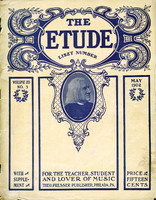Mr. L. T. Downs, who has been an active organist for sixty-two years, retired from his late position as organist of the Church of Epiphany, Providence, R. I., last February. Mr. Downs was born in Water- bury, Conn., in 1824, and in March, 1849, he began his career as organist of St. John’s Church in that city. Later he went to Hartford, and after returning to Waterbury he moved to Providence, where he remained till he retired.
* * *
Just before his departure from England for this country Mr. Edwin H. Lemare was interviewed by a writer of the London Musical Standard. When asked for his opinion of the American pipe-organs he replied: “In mechanism they are ahead of English organs; electric action is used throughout, and most of them have movable consoles. Not that I like the movable consoles,” he added, “for when placed far from the organ the organist is in much the same position as a conductor who had to direct the Queen’s Hall Orchestra from the grand circle. The fault with the American organs is that they are too much the development of the reed-organ. There is a deal of the harmonium about them, and all are on too low a wind-pressure. The lighter work—the flutes and so on—is good; but, in general, the instruments have not the power and richness of tone of our best English organs.” He was very complimentary of the treatment which he had received from the organists of this country, saying that “one and all were geniality itself.”
He disapproved of the “cock and hen” choirs which are so general in this country, though he admitted that a quartet of gifted and finely trained soloists might be of much use in conjunction with an ordinary boy choir.
* * *
Mr. George William Warren, for thirty years organist of St. Thomas’ Church, New York, died very suddenly of apoplexy, March 9th. Mr. Warren was born in Albany, August 27, 1828. After filling positions in Albany and New York he became organist and choirmaster of Holy Trinity, Brooklyn. In 1870 he went to St. Thomas’ Church, and remained till 1900, when he was made organist emeritus of the parish.
* * *
Mr. William C. Carl recently celebrated his tenth anniversary as organist of the First Presbyterian Church, New York, giving a special program of organ-music much of which has been dedicated to him.
* * *
The following description of an organ-recital is taken from a local paper of one of the cities of Ireland:
The curfew was tolling “the knell of parting day” from the old tower where it has rung out its music for nearly a century, now softened like an old violin by long use and the touch of time. At eight o’clock p.m. the bell ceased, and the tone of an organ playing an Introit induced us to go in. A large crowd had assembled in the body of the church. After some preliminary prayers by the rector and curate, the recital began. We took a seat pretty high up, in order to get a view of the organ, and began repeating in our own minds Milton’s celebrated description of church music in his “Il Penseroso.” There is no mistake but the recital was well planned. What with the glamor of the twilight through the tinted glass of Gothic windows, the gathering darkness, and “dim religious light” from candles on the communion table and reading desk and organ-loft, the hush, the silence, and the sacred solemnity of the surroundings, all conspired to heighten the effect and give one the idea of being in an ancient cathedral in the twelfth century. Anon the seats begin to shake, though we hardly hear a sound yet, but are conscious of a deep vibration like an earth-tremor. Then the double diapason and 16-foot pipes play a caper or two, while the stopped-diapason with wood and metal flutes steal gently in a cantabile movement; then the glorious fugue begins, movement chasing movement, melody pursuing melody, as if in play with the deep-toned cornopean, now and then expostulating with them not to break the bounds of classic decency. No wonder all eyes were turned toward the organ-loft, as if something supernatural were up there. Again, and there is a graceful dancing run, a veritable polka, or pas de catch up the scale and down again; a chromatic chase over the keys, as if the right hand were running away, and the left, being out of breath, trying to catch it, turned back and began to cry, while the right, having reached the summit of the keyboard, was reveling on flute and piccolo. Then the bass and treble come back again, shake hands, fondle, and again fall out, and then another musical storm, till our heads reeled, and the senses, intoxicated by such display, began to anticipate a general blow up of pipes, bellows, and all, when the storm gently subsided, and a sweet melody supervening reassures us that there is not the slightest danger. We sit back in our seats, cross our legs, and give a sigh of relief. Then there is a pause, a hymn during the offertory (“Giver of all”) being sung; but to our mind “Lead, kindly Light” would have been more appropriate “amid the encircling gloom.”
* * *
A three-manual organ to cost about $16,000 is being built by the Hutchings-Votey Company for the new building of the New England Conservatory of Music, and will be the gift of Mr. Eben D. Jordan to the institution. It will be placed in the fine new hall which is to be a part of the new building. Another three-manual organ and ten small two-manual organs as practice-organs are also being built for the institution. The conservatory will thus have the largest equipment of organs of any similar institution in the world. These organs will all be blown from one central blowing-plant.



